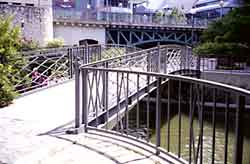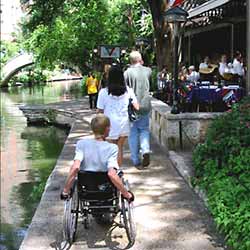|
San Antonio, Texas
A world famous landmark, the River Walk,
and other city programs and services are becoming more accessible than ever before.
 Pausing near the base of one of the many beautiful waterfalls along San Antonio’s famous and historic River Walk, Judy Babbitt, a wheelchair user, takes a breath then slowly exhales while listening to the relaxing sound of the water cascading down the rock embankment. “I could never see this side of the river before the access ramp was constructed,” Judy explained. “Well, I guess you could ‘see’ it from the other side, but you couldn’t ‘hear’ the water.” Babbitt, who also serves as the manager of the city of San Antonio's Disability Access Office, sums up her feelings quite simply when she says that fully experiencing her City is “... what ADA means to me.” Pausing near the base of one of the many beautiful waterfalls along San Antonio’s famous and historic River Walk, Judy Babbitt, a wheelchair user, takes a breath then slowly exhales while listening to the relaxing sound of the water cascading down the rock embankment. “I could never see this side of the river before the access ramp was constructed,” Judy explained. “Well, I guess you could ‘see’ it from the other side, but you couldn’t ‘hear’ the water.” Babbitt, who also serves as the manager of the city of San Antonio's Disability Access Office, sums up her feelings quite simply when she says that fully experiencing her City is “... what ADA means to me.”
Until recently, it wasn't possible for people with disabilities to fully experience San Antonio, home to one million people, the ninth largest city in the United States. Back in 1993, the Department worked with the city of San Antonio to make the River Walk more accessible and welcoming to people with disabilities, including those who use wheelchairs. Located 20 feet below street level, the River Walk consists of cobblestone and flagstone paths that run along each side of the spring-fed San Antonio River through the business district. Before the city took on this project, access for people with disabilities was severely limited. With accessible entrances only at each endpoint of the two-and-a-half-mile walkway, someone who could not climb stairs couldn't easily reach the many shops and restaurants along the way. The lack of accessible bridges to cross the river left people with disabilities stranded on one side or the other. Although both the scope and historic significance made the project a challenging one for the city, the city responded and was clearly up to the task.
 Now, people with disabilities can truly experience all the River Walk has to offer. The days of being stuck on the River Walk until one reached the accessible entrance at each end are long gone – there are now three access ramps descending from street level and four elevator access routes from riverside hotels. Wheelchair users can now cross the river via an accessible bridge. And directional signage now ensures that patrons with disabilities can take full advantage of the accessible routes by pointing them in the right direction. New hotels and businesses have agreed to provide direct access from their businesses to the River Walk. All of which permit thousands of people with disabilities to more fully experience one of San Antonio's major attractions. Now, people with disabilities can truly experience all the River Walk has to offer. The days of being stuck on the River Walk until one reached the accessible entrance at each end are long gone – there are now three access ramps descending from street level and four elevator access routes from riverside hotels. Wheelchair users can now cross the river via an accessible bridge. And directional signage now ensures that patrons with disabilities can take full advantage of the accessible routes by pointing them in the right direction. New hotels and businesses have agreed to provide direct access from their businesses to the River Walk. All of which permit thousands of people with disabilities to more fully experience one of San Antonio's major attractions.
According to Babbitt, the city has developed a positive, on-going approach to increasing access for all its citizens and visitors. “To be successful in addressing the access needs of citizens, accessibility had to be a part of an on-going budget for each agency.” Every agency or department in the San Antonio city government has its own ADA Coordinator, advisory team, and budget. On a regular basis, each department evaluates its programs, services, and activities to ensure that citizens and visitors with all types of disabilities can access them. If changes must be made to provide access, the individual department has the financial responsibility for making them. Babbitt says this unique, decentralized strategy has worked well in San Antonio. “You can see the pride each Department takes in having direct responsibility for accessibility.”
 This pride continues to move the city forward. Following a 1999 compliance review by the Department, the city has committed to making itself even more accessible to residents and visitors with disabilities. For the next 24 months, the city will make significant accessibility modifications to buildings throughout San Antonio, including the city hall and annex, the convention center, several city parks, police headquarters and substations, theaters, a courthouse, and other buildings. Barriers to access, such as inaccessible entrances, toilet rooms, parking, service counters, and wheelchair seating, will be removed. The city has also agreed to install raised letter and Braille signage, as well as signage directing people with disabilities to accessible features, in buildings throughout the City, where needed. The city will also include its TTY telephone numbers on all letters sent to the public from every city office, ensuring that people with communication disabilities can conduct business with the city directly by telephone. This pride continues to move the city forward. Following a 1999 compliance review by the Department, the city has committed to making itself even more accessible to residents and visitors with disabilities. For the next 24 months, the city will make significant accessibility modifications to buildings throughout San Antonio, including the city hall and annex, the convention center, several city parks, police headquarters and substations, theaters, a courthouse, and other buildings. Barriers to access, such as inaccessible entrances, toilet rooms, parking, service counters, and wheelchair seating, will be removed. The city has also agreed to install raised letter and Braille signage, as well as signage directing people with disabilities to accessible features, in buildings throughout the City, where needed. The city will also include its TTY telephone numbers on all letters sent to the public from every city office, ensuring that people with communication disabilities can conduct business with the city directly by telephone.
The city of San Antonio has come a long way since it took its initial accessibility steps on the River Walk. Its continuing commitment to bring people with disabilities into the mainstream of the community has been clearly stated. From the River Walk to City Hall, from Monterey Park to the Municipal Courthouse, people with disabilities can be assured that they will be able to fully participate in the San Antonio experience.
Donna McBee, a San Antonio resident who is blind and navigates the city with the help of Clarisse, her German Shepherd service animal, confirms the positive changes taking place in San Antonio. “I first moved to the city in 1981 and would navigate the city streets with a cane. I had to find the curb cuts with my cane. When I couldn't find a curb cut, I wasn’t always certain of my safety when crossing the street. It also made me very aware of the mobility problems faced by wheelchair users. The city just wasn’t very accessible back then. Since the passage of the ADA, access has improved greatly and mobility is much easier. So much has changed!”
|